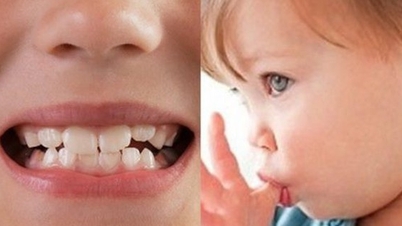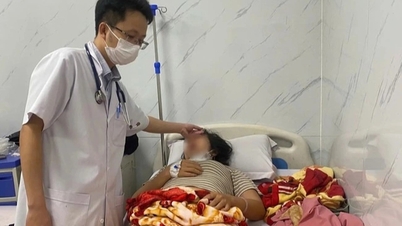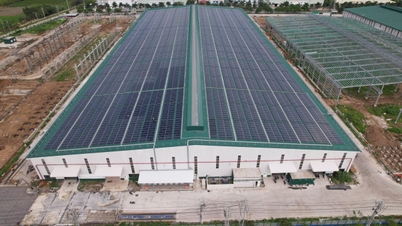Iron is a vital mineral for red blood cell health, found in two red blood cell proteins: hemoglobin and myoglobin. Iron helps transport oxygen from the lungs to the rest of the body and supports connective tissue health.

Dark green leafy vegetables such as spinach and kale are good sources of iron - Illustration image
Iron deficiency can occur if you have conditions that reduce your body's ability to absorb iron, such as inflammatory bowel disease or celiac disease. People who don't consume enough iron-rich foods or who have higher iron needs due to pregnancy or breastfeeding are also more susceptible to deficiency.
Because iron is present in the blood, blood loss can also cause iron deficiency, from heavy menstruation, gastrointestinal bleeding, trauma, or urinary tract bleeding. Early recognition of iron deficiency signs is crucial to prevent serious complications such as cardiovascular problems, pregnancy complications, or developmental delays in children.
Feeling tired
Fatigue is one of the most common symptoms of iron deficiency. You may feel weak and tired for no apparent reason, even after getting enough sleep. This happens because iron deficiency reduces hemoglobin, preventing sufficient oxygen from being transported to the tissues.
Iron deficiency is also linked to sleep disorders such as insomnia and restless leg syndrome, disrupting sleep and increasing feelings of fatigue. This feeling, along with other symptoms, may indicate that you are iron deficient.
My hands and feet are always cold.
Constantly cold hands and feet can be a sign of iron deficiency, even when the surrounding environment isn't cold. Similar to fatigue, this symptom is related to the role of hemoglobin in the body.
When hemoglobin levels are low, blood circulation decreases, preventing oxygen from being transported efficiently to distant areas like the hands and feet. You may feel colder than others, not just in your hands and feet, but throughout your entire body.
Unusually pale skin
You may have an iron deficiency if your skin is paler than normal. Pale skin is a sign of reduced blood circulation, which can occur when the body is unable to produce red blood cells due to anemia.
This symptom can manifest differently depending on skin pigmentation. Pallor may be more noticeable in lighter skin tones, and may be visible on the face. In areas with darker skin tones, unusual pallor may be more easily detected inside the mouth and on the mucous membranes of the eyes.
Dizziness or lightheadedness
Another common symptom of iron deficiency is dizziness or lightheadedness. This occurs because when the body lacks iron, there aren't enough red blood cells to carry oxygen to the brain and other organs.
Dizziness isn't a symptom unique to iron deficiency; it can signal a variety of other health problems of varying severity. Consider whether you're experiencing this along with other signs of iron deficiency.
Frequent headaches
When the brain doesn't receive enough oxygen, you may experience headaches. Iron deficiency can also cause blood vessels to swell, creating pressure and leading to headaches. Anemia has a strong link between iron deficiency and chronic daily headaches. Additionally, migraines are also common in people with iron deficiency.
Weak or brittle hair and nails
Brittle nails can be a sign of iron deficiency. As iron deficiency progresses, you may develop koilonychia, a condition where the nails curve inward and have a raised edge, resembling a spoon. About 5% of people with iron deficiency experience this condition, due to abnormal blood flow to the nails and mechanical pressure causing the outer part of the nail to grow upwards.
Iron deficiency can also cause thinning hair and hair loss due to a lack of nutrients and blood flow necessary for hair growth. Numerous studies have shown that iron deficiency is a common cause of hair loss.

Iron deficiency can also cause hair loss and thinning - Illustration.
How to check if you have an iron deficiency?
If you notice any signs or symptoms of iron deficiency, consider contacting your doctor. You should also talk to your doctor if you see blood or black, tar-like stools.
Doctors can check for iron deficiency through blood tests, including a complete blood count (CBC) and reticulocyte count. Additionally, tests for serum iron levels, total iron-binding capacity, and serum ferritin may also be performed to diagnose iron deficiency.
Tips for supplementing iron
To prevent or manage iron deficiency, start by eating iron-rich foods such as beans, dried fruit, eggs, lean red meat, salmon, iron-fortified cereals, peas, tofu, and dark leafy greens.
Combining these foods with sources of vitamin C (such as oranges, tomatoes, and strawberries) will help the body absorb iron better, especially from plant sources. If you are iron deficient or at risk, iron supplementation under the guidance of a doctor can help maintain the necessary iron levels in your body.
Your doctor can determine the appropriate dosage of iron supplements based on your current iron levels and health conditions. Restoring normal iron levels may take 3-6 months of supplementation.
Iron supplements can cause side effects such as nausea, diarrhea, or constipation. If these occur, your doctor may recommend taking them with food or reducing the dose.
In severe cases, you may need intravenous iron injections or blood transfusions. If the iron deficiency is due to internal bleeding or kidney disease, surgery or medication may be necessary to address the cause.
Source: https://tuoitre.vn/nhung-dau-hieu-suc-khoe-cho-thay-co-the-cua-ban-can-them-sat-20241227082453568.htm





![[Image] Vietnam's colorful journey of innovation](/_next/image?url=https%3A%2F%2Fvphoto.vietnam.vn%2Fthumb%2F1200x675%2Fvietnam%2Fresource%2FIMAGE%2F2025%2F12%2F14%2F1765703036409_image-1.jpeg&w=3840&q=75)

































































![[Image] Vietnam's colorful journey of innovation](https://vphoto.vietnam.vn/thumb/402x226/vietnam/resource/IMAGE/2025/12/14/1765703036409_image-1.jpeg)

































Comment (0)